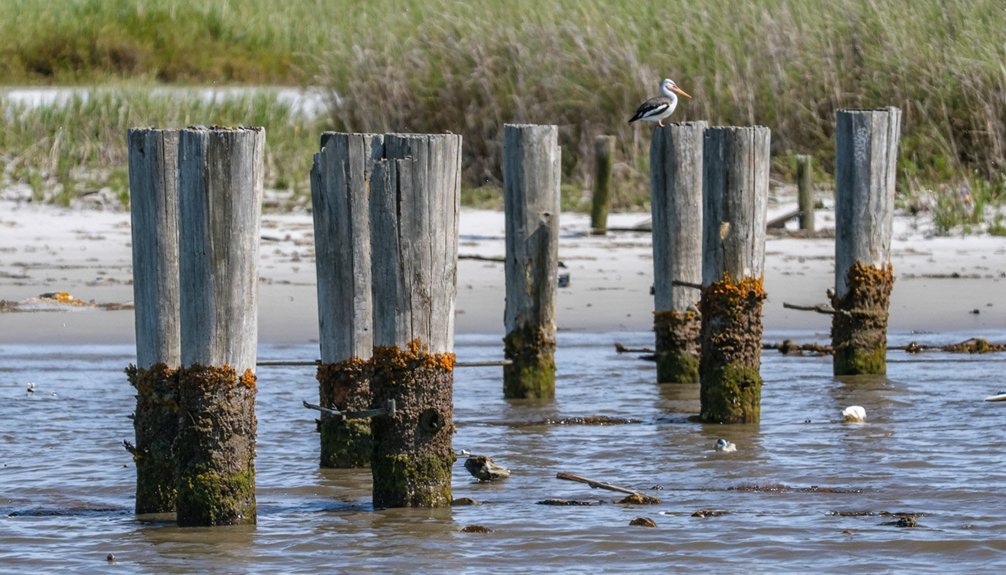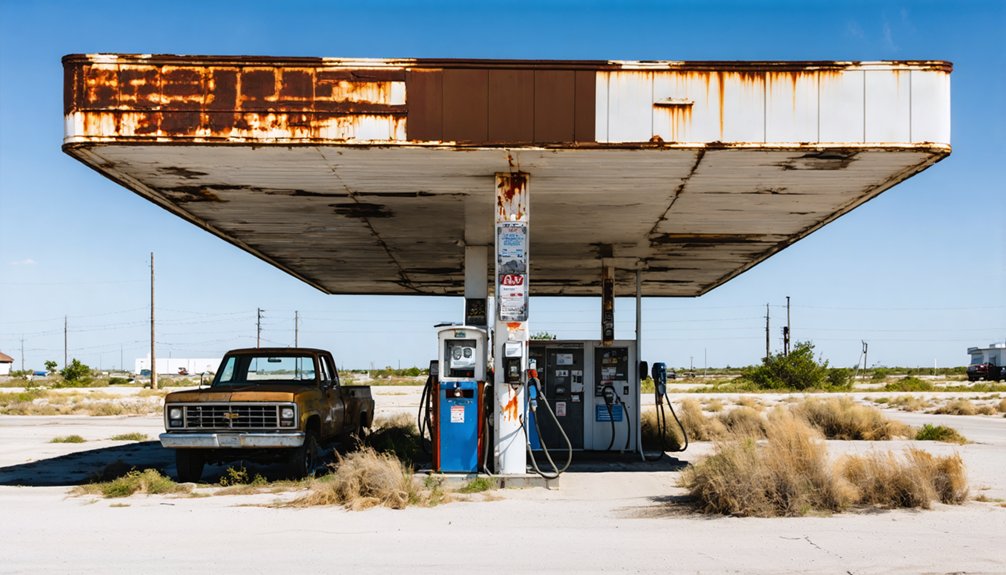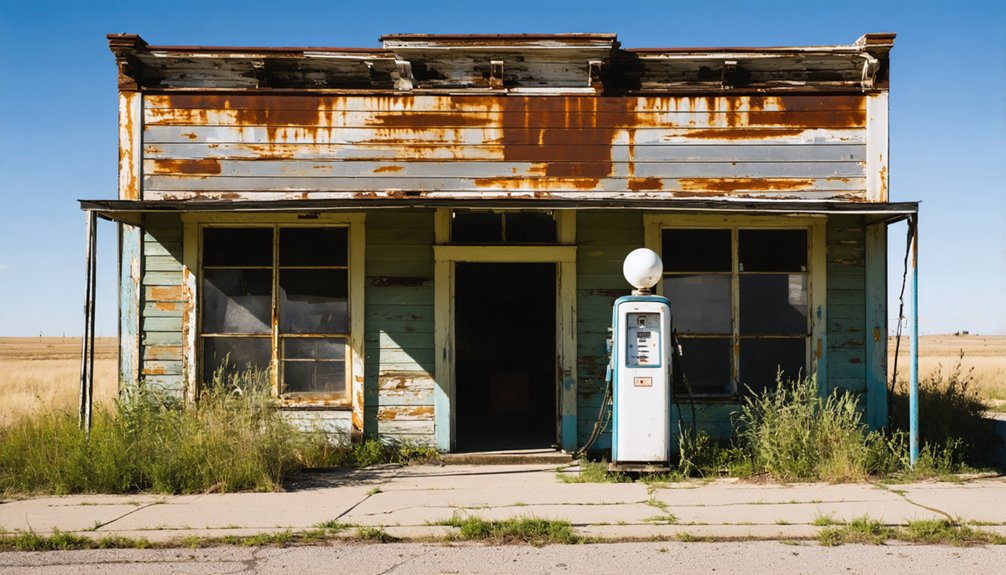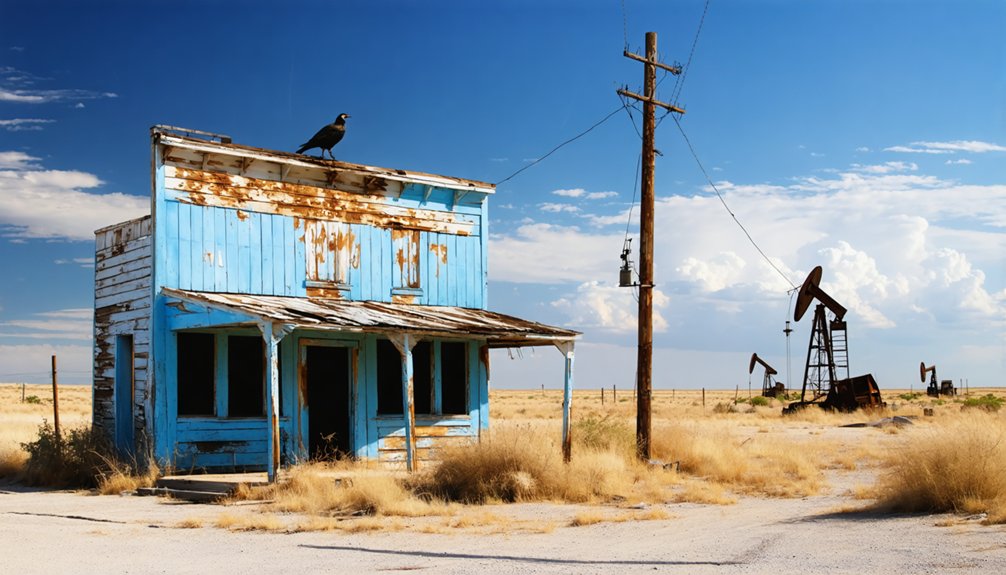You’ll discover the haunting remnants of Gulf, Texas, a once-thriving maritime hub that handled over 35 vessels weekly at its peak. From 1848 to 1875, this coastal powerhouse pioneered refrigerated beef shipments and facilitated vital trade routes between Mexico and inland Texas. The devastating Category 3 hurricane of 1875 claimed hundreds of lives and caused $4 million in damage, ultimately leading to the town’s abandonment. Its scattered ruins hold fascinating stories of ambition, innovation, and nature’s fury.
Key Takeaways
- Gulf served as a major Texas port town from 1848 to 1860, facilitating trade of cattle products and Mexican precious metals.
- A devastating Category 3 hurricane in 1875 caused massive destruction, killing 150-300 residents and causing $4 million in property damage.
- Multiple natural disasters, including storms, fires, and floods, led to the town’s eventual abandonment and ghost town status.
- The closure of essential services and shifting trade routes to other Texas ports like Galveston crippled Gulf’s economic viability.
- Historical remnants of Gulf remain accessible for exploration, preserving the memory of this once-thriving Texas coastal community.
The Rise of a Coastal Powerhouse
While Galveston dominated Gulf Coast shipping in the late 19th century, the Myers brothers from Duluth, Minnesota, envisioned a competing deep-water port on the mainland. They purchased 10,000 acres along Galveston Bay, establishing Texas City’s maritime heritage at Shoal Point.
You’ll find their ambitious vision took shape through strategic infrastructure development – dredging an 8-foot channel that would eventually reach 40 feet deep, and constructing essential rail connections to major national networks.
Though early financial challenges led to reorganization in 1897, the foundation for coastal industry was set. They built a pioneering single-track trestle pier extending into the bay, enabling direct ship-to-train cargo transfers. The port’s rapid growth was evident as ship usage increased from twelve vessels in 1904 to 239 by 1910.
Just 7 miles from Galveston and 40 miles from Houston, Texas City’s strategic position promised a new era of Gulf Coast commerce. The area saw major industrial growth with the establishment of the Texas City Refining Company in 1908.
Immigration Gateway to Texas
As Texas City’s port infrastructure expanded in the early 20th century, it became an essential gateway for immigrants seeking new opportunities in the American Southwest. The Gulf Coast’s strategic location shaped immigration patterns that would transform Texas’s demographic landscape. Like the Port of New Orleans, Texas ports became crucial export hubs for agricultural goods and raw materials.
Texas City’s expanding port served as a vital immigrant gateway, with its Gulf Coast location profoundly influencing the Southwest’s demographic evolution.
You’ll find that the coastal region’s influence on cultural integration extends far beyond its shores:
- The foreign-born population exploded from 310,000 in 1970 to 1.5 million by 1990, driving one-fifth of Texas’s growth.
- Mexican immigrants traditionally dominated the influx, though Asian immigration has risen considerably since 2000.
- Five metropolitan counties became magnets for newcomers, absorbing over 54% of immigrants by 2016.
- Maritime access and established trade routes made the Gulf Coast a natural entry point, particularly for Latin American immigrants.
These coastal gateways continue shaping Texas’s rich multicultural identity, especially in urban centers along the Gulf. The surge in immigration helped Texas reach 18.5 million residents by 1995, reflecting the state’s dramatic population growth.
Maritime Trade and Economic Growth
You’ll find Gulf’s economic power shifted dramatically as deepwater ports emerged along the Texas coast, with Galveston, Sabine Pass, Port Arthur, and Beaumont leading maritime commerce by 1910.
The development of steamship routes and infrastructure investments, particularly in the Houston Ship Channel, transformed the region’s trade capabilities, allowing access to larger vessels and expanding international commerce. Today, Houston stands as the busiest port along the Gulf Intracoastal Waterway, handling over 266 million tons annually. By 1890, there was a significant political and commercial push to establish deepwater ports throughout Texas.
The Gulf Intracoastal Waterway’s completion in 1946 created a protected maritime corridor that connected Texas ports from Brownsville to Florida, though this progress ultimately contributed to Gulf’s decline as economic activity concentrated around larger, modernized ports.
Port Infrastructure Development
From the early 1900s, Texas Gulf ports underwent dramatic infrastructure transformations that revolutionized maritime trade and shaped the region’s economic destiny.
You’ll find evidence of this port modernization in the continuous channel expansion efforts, which transformed modest waterways into deep-water powerhouses. Local civic leaders worked with Congress to establish a cost-sharing plan for channel development.
- Texas City’s channel depth increased from 25 to 30 feet by 1916, while Galveston achieved 40 feet by 1976
- The Industrial Canal emerged from dredging projects, maximizing operational efficiency
- Modern post-Panamax cranes now service massive container vessels
- Port Houston operates multiple terminals along a 52-mile ship channel with advanced breakbulk facilities
These improvements weren’t just about bigger ships – they’ve created an economic ripple effect.
The discovery of oil in the early 20th century catalyzed rapid expansion and modernization of existing port facilities.
Today’s $3.2 billion in facility upgrades are expected to leverage nearly $69 billion in private capital, securing Texas ports’ position as global trade leaders.
Steamship Routes and Commerce
While primitive sailing vessels once dominated Gulf waters, the introduction of steamship routes in the 1830s revolutionized maritime commerce along the Texas coast.
You’ll find that Charles Morgan’s pioneering steamship innovations established the first regular service between New Orleans and Veracruz, setting the stage for expansive trade routes throughout the Gulf region.
The acquisition of the David Brown in 1833 marked Morgan’s first side paddlewheel steamship and entry into steam-powered shipping.
Regional Economic Power Shifts
The economic landscape of Texas Gulf ports underwent a dramatic overhaul throughout the 20th century, marking a significant shift in regional maritime power.
You’ll find these economic alterations particularly evident in the rise of the Houston Ship Channel, which emerged as Texas’s premier port by 1936. The regional dynamics reshaped maritime commerce, as you can see from these key developments:
- By 1954, Texas Gulf Coast ports handled an astounding 138 million tons of cargo
- Federal investments transformed ports like Galveston and Port Arthur into deepwater facilities
- A dozen deepwater ports were operating by 1946, moving $1.8 billion in trade
- The Gulf Intracoastal Waterway created essential connections from New Orleans to Corpus Christi
This shift in power peaked when Texas surpassed Louisiana as America’s leading maritime commerce state by tonnage in 2019.
Life in 19th Century Indianola

You’d find life in 19th century Indianola centered around its bustling port, where German immigrants and traders conducted daily business in a town that briefly rivaled Galveston’s commercial prominence.
While the community lacked the plantation-based economy common elsewhere in Texas, you’d see a thriving mix of maritime commerce, military supply operations, and merchant activities that defined daily life.
The social fabric of Indianola was woven through hotels like Angelina Belle Eberly’s establishment, which served as gathering places for both residents and travelers from 1848 to 1860.
The town’s experimental use of mechanically refrigerated beef in 1869 demonstrated its pioneering role in shipping innovations.
Daily Commerce and Trade
Bustling with activity from the 1840s through the 1880s, Indianola’s port welcomed roughly 35 vessels weekly during its peak, positioning itself as Galveston’s primary rival for maritime commerce.
You’d find a diverse array of trade relationships that showcased the region’s economic diversification, from cattle products to Mexican precious metals.
The port’s strategic location and efficient operations supported:
- Direct ship-to-wagon transfers at the confluence of Matagorda and Lavaca Bays
- Pioneering refrigerated beef shipments to New Orleans in 1869
- Railroad connections linking ships directly to inland Texas markets
- Processing and export of local resources like turtle meat and pecans
The port’s prominence continued until the Civil War disrupted commerce in 1861, though Indianola later rebounded with modernized shipping methods and expanded railway connections.
Community Social Activities
While ships streamed through Indianola’s busy port, a vibrant social fabric wove through the town’s diverse population. You’d find social gatherings happening regularly in hotels run by figures like Angelina Belle Eberly, where German immigrants and local Texans mingled freely.
These establishments buzzed with music, dance, and shared meals that strengthened community cohesion. The town’s social life reflected its multicultural spirit, especially through the influence of German settlers who brought their folk traditions.
You could attend religious services that doubled as social occasions, participate in military parades during the Civil War period, or join celebrations that blended frontier customs with European flair. Local military groups like the Indianola Guards added another layer to the community’s identity, organizing events that united residents through shared purpose and patriotic sentiment.
The Devastating Hurricane of 1875
In September 1875, a catastrophic Category 3 hurricane with peak winds of 115 mph slammed into the Texas coast, delivering a devastating blow to the prosperous port town of Indianola. The hurricane’s impact was brutal, claiming between 150-300 lives in Indianola alone and up to 800 deaths along the coast.
The 1875 Indianola hurricane unleashed devastation on Texas, with 115 mph winds claiming hundreds of lives along the coast.
You can grasp the sheer force of coastal vulnerability through these stark facts:
- The storm obliterated nearly $4 million in property (equivalent to $115 million today)
- Massive 15-mile sections of Matagorda Peninsula were swept into the Gulf
- Heroic prisoners at the courthouse rescued countless drowning victims
- The Lewis building stood as a rare sanctuary, where D.W. Hatch Jr. lassoed 20-30 people to safety
This disaster ultimately sealed Indianola’s fate, shifting trade to Galveston and leaving the once-thriving port to sink beneath Matagorda Bay’s waters.
Final Days and Abandonment

Following the devastating 1875 hurricane, Gulf’s downward spiral accelerated through a perfect storm of economic and natural challenges.
You’d have witnessed the town’s final population decline as younger residents sought opportunities elsewhere, leaving aging locals behind in deteriorating conditions.
Additional storms, fires, and floods battered the remaining structures while shifting trade routes and railroad bypasses crippled Gulf’s economic viability collapse.
As infrastructure crumbled and essential services disappeared, even the most determined residents were forced to relocate.
The closure of general stores, banks, and the post office marked the end of Gulf’s viability as a functioning community.
What Remains Today
Today, scattered remnants of Gulf’s once-thriving community dot the coastal landscape, offering glimpses into its vanished past.
During your ruins exploration, you’ll discover stone foundations, partial walls, and weathered gravesites marked with rustic crosses and rocks. The ghost town’s natural habitats now embrace these historic remains, creating an eerily beautiful scene where coastal wetlands meet desert-like terrain.
- Original building foundations lie partially submerged due to rising water levels
- Historic cemeteries preserve stories through handmade markers and grave sites
- Surviving stone structures reveal early architectural styles and building methods
- Interpretive signs and markers help you understand Gulf’s fascinating history
You’re free to explore these remnants, as the area remains largely undeveloped and open for camping, fishing, and quiet reflection among the windswept ruins.
Historical Significance and Preservation

While the physical remains of Gulf offer tangible connections to the past, the site’s broader historical significance extends far beyond its visible ruins.
As Texas’s second-largest port in the 19th century, Gulf served as an essential gateway for European immigrants, particularly German, Polish, and Czech families seeking new opportunities. You’ll find its cultural heritage deeply woven into the region’s development, from its role as a military supply depot to its function as a bustling commercial hub with a population of 5,000 by the 1870s.
Though devastating hurricanes in 1875 and 1886 ultimately led to its abandonment, Gulf’s historical legacy lives on through various commemorative efforts, including its designation as a Recorded Texas Historic Landmark in 1963 and ongoing museum exhibits in Calhoun County.
Frequently Asked Questions
What Role Did Native Americans Play in the Development of Indianola?
You’ll find that Native Americans, especially the Karankawa, shaped Indianola through tribal influence on place names and early trails, though there wasn’t significant cultural exchange during the town’s development.
How Did Indianola’s Education System Compare to Other Texas Towns?
You’ll find Indianola’s schools were more religiously focused and storm-vulnerable than other Texas towns, which built permanent brick schools. While both had public-private education, Indianola relied heavily on church facilities.
What Types of Diseases and Medical Challenges Affected Indianola’s Population?
You’d face deadly yellow fever, devastating cholera, and persistent smallpox outbreaks in Indianola, where primitive medical treatments and poor sanitation made survival challenging during frequent disease outbreaks that ravaged the population.
Were There Any Famous Shipwrecks or Maritime Disasters Near Indianola’s Port?
While shipwreck history near Indianola isn’t well documented, you’ll find maritime safety was severely compromised during the 1875 and 1886 hurricanes, which destroyed lighthouses and filled the harbor with storm debris.
How Did Local Wildlife and Fishing Practices Influence Indianola’s Daily Life?
Like ancient mariners, you’d rely heavily on Matagorda Bay’s bounty, using traditional fishing techniques to catch shrimp, oysters, and fish. Wildlife conservation wasn’t practiced then, but nature’s cycles dictated your daily routines.
References
- https://www.youtube.com/watch?v=Y0__p2rhMMc
- https://mix941kmxj.com/see-how-two-texas-ghost-towns-battled-for-the-county-and-lost/
- https://929thelake.com/texas-ghost-towns/
- https://en.wikipedia.org/wiki/Indianola
- https://texascooppower.com/south-texas-lost-ghost-town-of-linnville/
- https://knue.com/ghost-town-indianola-texas/
- https://www.chron.com/gulf-coast/article/south-galveston-texas-ghost-town-20361539.php
- https://knue.com/texas-gulf-ghost-town-indianola/
- https://www.texasescapes.com/TOWNS/Texas-Ghost-Towns-7-Texas-Gulf-Coast.htm
- https://houstonhistorymagazine.org/wp-content/uploads/2015/12/10.3-Texas-City-Port-of-Oppurtunity-Priscilla-Benham-.pdf



